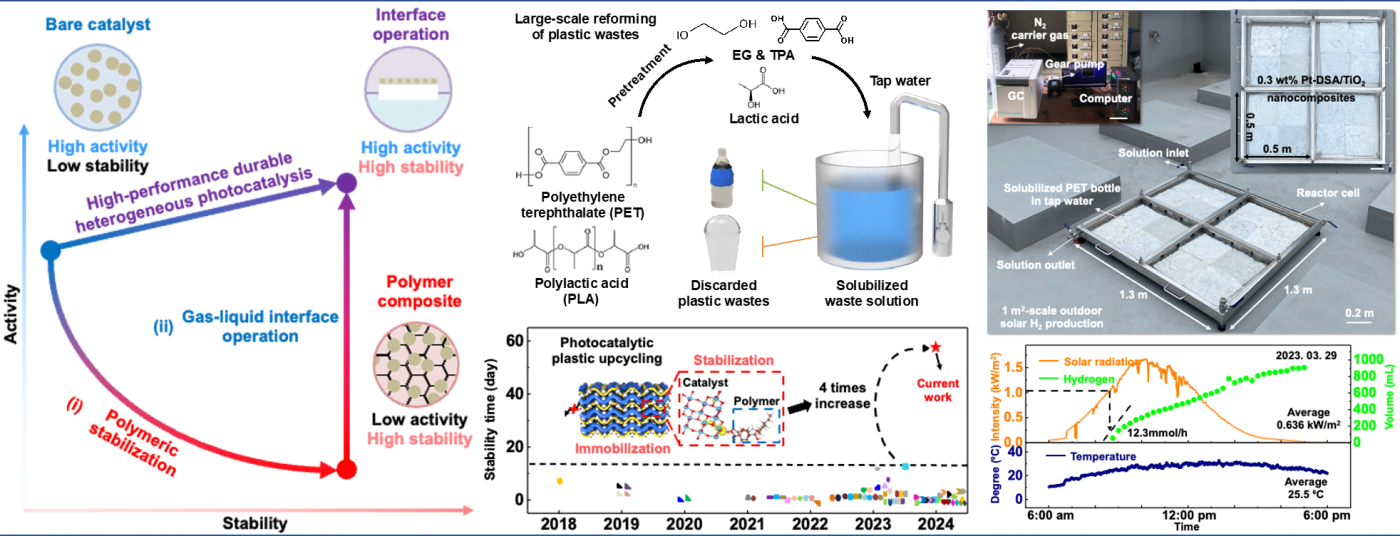Key Technologies
Translational Soft Electronics Group
Hydrogel Thermostat Inspired by Photoprotective Foliage Using Latent and Radiative Heat Control
Plants such as Populus alba feature photoprotective foliage that dynamically modulates optical properties to dissipate excessive heat under high temperatures, while condensation-induced latent heating preserves warmth under cold conditions—enabling tolerance to fluctuating thermal and hydric environments. Inspired by this natural strategy, a hydrogel-based thermostat is presented that balances latent and radiative heat fluxes. The system integrates lithium ions and hydroxypropyl cellulose into a polyacrylamide matrix, providing dynamic solar reflectance, high infrared emissivity, and reversible water sorption–desorption capabilities. Thermochromic and hygroscopic responses are tunable via adjustments in hydroxypropyl cellulose and lithium ions concentrations, allowing environment-specific adaptation. Mechanical robustness is enhanced by incorporating titanium dioxide nanoparticles and applying surface treatments. Experiments and simulations demonstrate both sub-ambient cooling and above-ambient heating across diverse conditions, establishing the system as an all-season thermal regulation platform.
Advanced Materials, e16537, 2025
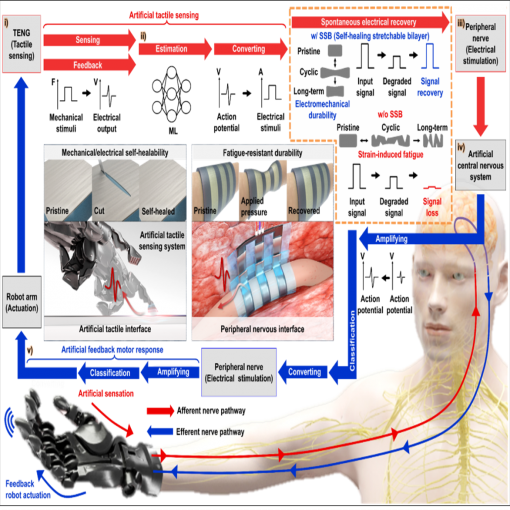
Performance-Recoverable Closed-Loop Neuroprosthetic System
Soft bioelectronics mechanically comparable to living tissues have driven advances in closed-loop neuroprosthetic systems for the recovery of sensory-motor functions. Despite notable progress in this field, critical challenges persist in achieving long-term stable closed-loop neuroprostheses, particularly in preventing uncontrolled drift in the electrical sensitivity and/or charge injection performance owing to material fatigue or mechanical damage. Additionally, the absence of an intelligent feedback loop has limited the ability to fully compensate for sensory-motor function loss in nervous systems. Here, a novel class of soft, closed-loop neuroprosthetic systems is presented for long-term operation, enabled by spontaneous performance recovery and machine-learning-driven correction to address the material fatigue inherent in chronic wear or implantation environments. Central to this innovation is the development of a tough, self-healing, and stretchable bilayer material with high conductivity and exceptional cyclic durability employed for robot-interface touch sensors and peripheral-nerve-adaptive electrodes. Furthermore, two central processing units, integrated in a prosthetic robot and an artificial brain, support closed-loop artificial sensory-motor operations, ensuring accurate sensing, decision-making, and feedback stimulation processes. Through these characteristics and seamless integration, our performance-recoverable closed-loop neuroprosthesis addresses challenges associated with chronic-material-fatigue-induced malfunctions, as demonstrated by successful in vivo under 4 weeks of implantation and/or mechanical damage.
Advanced Materials, 37: 2503413, 2025

Materials design and integration strategies for soft bioelectronics in digital healthcare
Advancements in bioelectronics are revolutionizing traditional healthcare by shifting the focus from in-hospital disease diagnosis and treatment to at-home continuous preventive care. This transformation integrates real-time health monitoring and point-of-care interventional therapies and enables artificial intelligence-based health management strategies. However, the mechanical mismatch between rigid bioelectronic devices and soft biological tissues presents important challenges, particularly in long-term applications, including poor adhesion, tissue degeneration, high noise level, signal interference and device instability. To address these challenges, soft bioelectronics — leveraging high-performance, tissue-mimicking and mechanically soft materials — has emerged as a disruptive solution. This Review highlights advancements in materials design and system-level integration strategies for soft bioelectronics, driving the development of next-generation digital healthcare technologies. We categorize materials design approaches, introduce fabrication techniques for soft bioelectronics and explore integration methods. Furthermore, we showcase applications of wearable and implantable soft bioelectronics, demonstrating their potential for continuous health monitoring and therapeutic interventions, ultimately enabling closed-loop health management.
Nature Reviews Materials, 10: 654, 2025
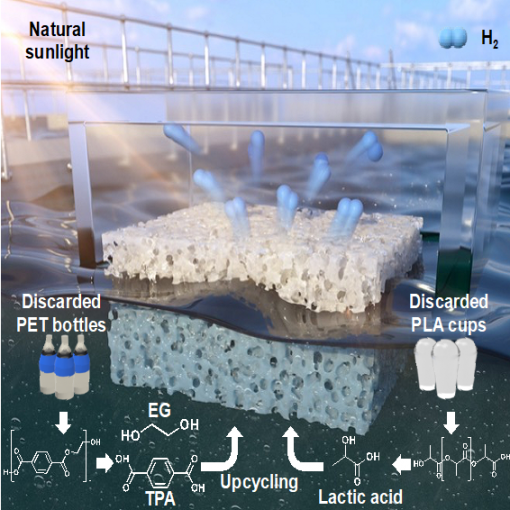
Polymeric stabilization at the gas–liquid interface for durable solar hydrogen production from plastic waste
Heterogeneous photocatalysis offers substantial potential for sustainable energy conversion, yet its industrial application is constrained by limited durability under stringent photochemical conditions. Achieving high photocatalytic activity often requires harsh reaction conditions, compromising catalyst stability and longevity. Here we propose a strategy involving polymeric stabilization of photocatalytic centres uniquely localized at the gas–liquid interface, substantially enhancing both the catalytic activity and stability. Applied to the photocatalytic conversion of plastic waste into solar hydrogen, this approach maintained its catalytic performance over 2 months under harsh conditions. Using 0.3 wt% dynamically stabilized atomic Pt/TiO2 photocatalysts and concentrated sunlight, we achieved a plastic reforming activity of 271 mmolH2 h−1 m−2. Scaling to 1 m2 under natural sunlight yielded a hydrogen production rate of 0.906 l per day from polyethylene terephthalate waste. Economic analysis and extensive-scale simulations suggest this strategy as a promising pathway for high-performance, durable photocatalysis, advancing renewable energy conversion.
Nature Nanotechnology, 20: 1237, 2025

Intrinsically-Stretchable and Patternable Quantum Dot Color Conversion Layers for Stretchable Displays in Robotic Skin and Wearable Electronics
Stretchable displays are essential components as signal outputs in next-generation stretchable electronics, particularly for robotic skin and wearable device technologies. Intrinsically-stretchable and patternable color conversion layers (CCLs) offer practical solutions for developing full-color stretchable micro-light-emitting diode (LED) displays. However, significant challenges remain in creating stretchable and patternable CCLs without backlight leakage under mechanical deformation. Here, a novel material strategy for stretchable and patternable heavy-metal-free quantum dot (QD) CCLs, potentially useful for robotic skin and wearable electronics is presented. Through a versatile crosslinking technique, uniform and high-concentration QD loading in the elastomeric polydimethylsiloxane matrix without loss of optical properties is achieved. These CCLs demonstrate excellent color conversion capabilities with minimal backlight leakage, even under 50% tensile strain. Additionally, fine-pixel patterning process with resolutions up to 300 pixels per inch is compatible with the QD CCLs, suitable for high-resolution stretchable display applications. The integration of these CCLs with micro-LED displays is also demonstrated, showcasing their use in haptic-responsive robotic skin and wearable healthcare monitoring sensors. This study offers a promising material preparation methodology for stretchable QDs/polymer composites and highlights their potential for advancing flexible and wearable light-emitting devices.
Advanced Materials, 37: 2420633, 2025
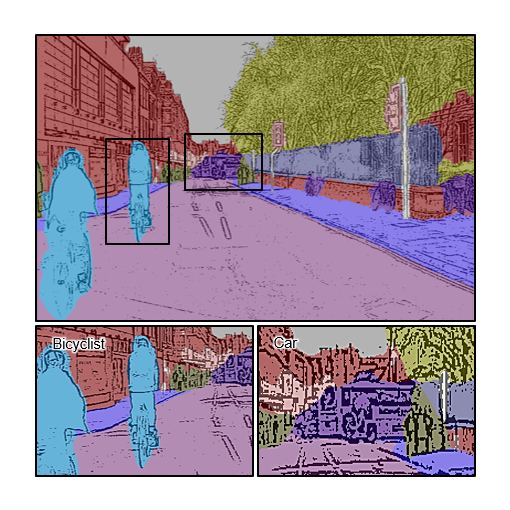
In-sensor multilevel image adjustment for high-clarity contour extraction using adjustable synaptic phototransistors
Robotic vision has traditionally relied on high-performance yet resource-intensive computing solutions, which necessitate high-throughput data transmission from vision sensors to remote computing servers, sacrificing energy efficiency and processing speed. A promising solution is data compaction through contour extraction, visualizing only the outlines of objects while eliminating superfluous backgrounds. Here, we introduce an in-sensor multilevel image adjustment method using adjustable synaptic phototransistors, enabling the capture of well-defined images with optimal brightness and contrast suitable for achieving high-clarity contour extraction. This is enabled by emulating dopamine-mediated neuronal excitability regulation mechanisms. Electrostatic gating effect either facilitates or inhibits time-dependent photocurrent accumulation, adjusting photo-responses to varying lighting conditions. Through excitatory and inhibitory modes, the adjustable synaptic phototransistor enhances visibility of dim and bright regions, respectively, facilitating distinct contour extraction and high-accuracy semantic segmentation. Evaluations using road images demonstrate improvement of both object detection accuracy and intersection over union, and compression of data volume.
Science Advances, 11: adt6527, 2025
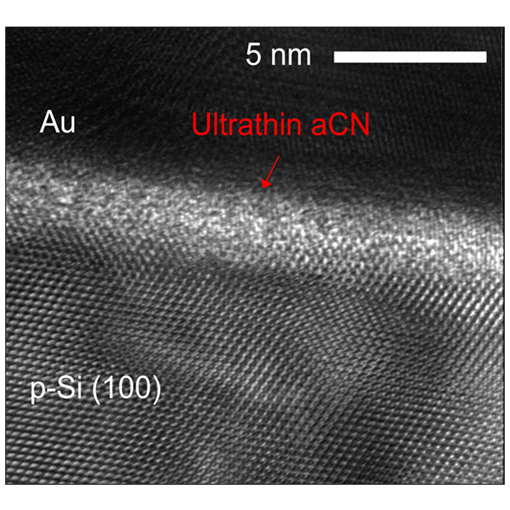
Covalent hetero structures of ultrathin amorphous carbon nitride and Si for high-performance vertical photodiodes
Despite its versatility in photocatalysis, the application of carbon nitride (CN) to optoelectronic devices, especially silicon (Si) optoelectronics, has been constrained by a lack of synthetic methods for producing large-scale, highly uniform and processable films. Here we report a large-scale synthesis of ultrathin amorphous carbon nitride (aCN) on Si, achieving high uniformity, ultralow surface roughness and a covalently bonded interface with Si. The ultrathin aCN on Si (aCN/Si) is synthesized via a two-step process involving a dual-heating-zone chemical vapour deposition and subsequent postannealing in a hydrogen atmosphere. During the postannealing process, the initially formed bilayer of polymeric CN and underlying aCN undergoes material transformations, including thinning of the CN film, increasing spatial uniformity and covalent bond formation between nitrogen and silicon atoms, producing a high-quality aCN/Si heterostructure. Based on this aCN/Si, we developed vertical photodiodes that function both as electrical diodes with high rectification ratio (3.8 × 108) and photodetectors with high specific detectivity (1.9 × 1012 Jones), fast photoresponse (6.7 µs) and a broad linear dynamic range (>130 dB). Integrating these aCN/Si vertical photodiodes with amorphous indium-gallium-zinc oxide switching thin-film transistors enables active-matrix-based multispectral imaging across the visible to near-infrared spectrum range.
Nature Synthesis, 4: 514, 2025

Feline eye–inspired artificial vision for enhanced camouflage breaking under diverse light conditions
Biologically inspired artificial vision research has led to innovative robotic vision systems with low optical aberration, wide field of view, and compact form factor. However, challenges persist in object detection and recognition against complex backgrounds and varied lighting. Inspired by the feline eye, which features a vertically elongated pupil and tapetum lucidum, this study introduces an artificial vision system designed for superior object detection and recognition in a monocular framework. Using a slit-like elliptical aperture and a patterned metal reflector beneath a hemispherical silicon photodiode array, the system reduces excessive light and enhances photosensitivity. This design achieves clear focus under bright light and enhanced sensitivity in dim conditions. Theoretical and experimental analyses demonstrate the system’s ability to filter redundant information and detect camouflaged objects in diverse lighting, representing a substantial advancement in monocular camera technology and the potential of biomimicry in optical innovations.
Science Advances, 10: eadp2809, 2024

Closed-loop photo- and electrocatalysis using floatable hierarchical hydrogel device for efficient waste-derived fuel production
Continuous and sustainable fuel production is essential for transitioning to a green-energy society. Solar-fuel production via photocatalysis is renewable but limited by vulnerability to weather dependence and suboptimal efficiency, necessitating an innovative solution. We present a feedback-controlled closed-loop system integrating photo- and electrocatalysis within a compact, floatable device. This system compensates for solar-fuel production shortfalls with electrochemical methods, optimizing catalyst pairings for high activity, selectivity, and durability. The unique floatability maximizes solar-to-fuel conversion efficiency with gas-liquid interface-operating photocatalysts and fully utilized submerged electrocatalysts. This dual-mode elastomer-hydrogel device achieves a plastic-waste-reforming activity of 269 mmol-H2/h⋅m2 using concentrated sunlight and also demonstrates nearly 100% Faradaic efficiency and selectivity in formate production. Scaling up to 1 m2 yields 23.7 mmol/h and 3.05 L/day hydrogen from polyethylene terephthalate (PET) bottles under natural sunlight, maintaining stable production over a month. This closed-loop system shows a promise for steady and economically viable fuel production.
Device, 2: 100515, 2024
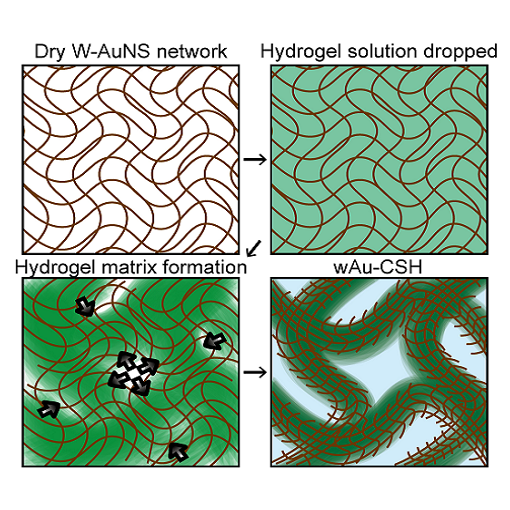
Highly Conductive and Stretchable Hydrogel Nanocomposite Using Whiskered Gold Nanosheets for Soft Bioelectronics
The low electrical conductivity of conductive hydrogels limits their applications as soft conductors in bioelectronics. This low conductivity originates from the high water content of hydrogels, which impedes facile carrier transport between conductive fillers. This study presents a highly conductive and stretchable hydrogel nanocomposite comprising whiskered gold nanosheets. A dry network of whiskered gold nanosheets is fabricated and then incorporated into the wet hydrogel matrices. The whiskered gold nanosheets preserve their tight interconnection in hydrogels despite the high water content, providing a high-quality percolation network even under stretched states. Regardless of the type of hydrogel matrix, the gold-hydrogel nanocomposites exhibit a conductivity of ≈520 S cm−1 and a stretchability of ≈300% without requiring a dehydration process. The conductivity reaches a maximum of ≈3304 S cm−1 when the density of the dry gold network is controlled. A gold-adhesive hydrogel nanocomposite, which can achieve conformal adhesion to moving organ surfaces, is fabricated for bioelectronics demonstrations. The adhesive hydrogel electrode outperforms elastomer-based electrodes in in vivo epicardial electrogram recording, epicardial pacing, and sciatic nerve stimulation.
Advanced Materials, 36: 2407931, 2024

Anti-distortion Bioinspired Camera with an Inhomogeneous Photo-pixel Array
The bioinspired camera, comprising a single lens and a curved image sensor—a photodiode array on a curved surface—, was born of flexible electronics. Its economical build lends itself well to space-constrained machine vision applications. The curved sensor, much akin to the retina, helps image focusing, but the curvature also creates a problem of image distortion, which can undermine machine vision tasks such as object recognition. Here we report an anti-distortion single-lens camera, where 4096 silicon photodiodes arrayed on a curved surface in a nonuniform pattern assimilated to the distorting optics are the key to anti-distortion engineering. That is, the photo-pixel distribution pattern itself is warped in the same manner as images are warped, which correctively reverses distortion. Acquired images feature no appreciable distortion across a 120° horizontal view, as confirmed by their neural-network recognition accuracies. This distortion correction via photo-pixel array reconfiguration is a form of in-sensor computing.
Nature Communications, 15: 6021, 2024
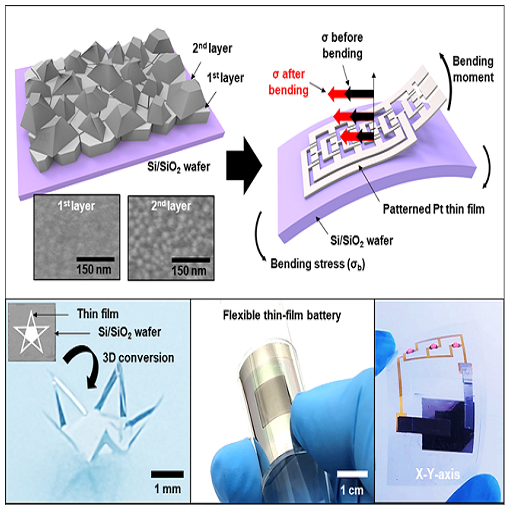
Damage-Free Dry Transfer Method using Stress Engineering for High-Performance Flexible Two- and Three-Dimensional Electronics
Advanced transfer printing technologies have enabled the fabrication of high-performance flexible and stretchable devices, revolutionizing many research fields including soft electronics, optoelectronics, bioelectronics and energy devices. Despite previous innovations, challenges remain, such as safety concerns due to toxic chemicals, the expensive equipment, film damage during the transfer process and difficulty in high-temperature processing. Thus a new transfer printing process is needed for the commercialization of high-performance soft electronic devices. Here we propose a damage-free dry transfer printing strategy based on stress control of the deposited thin films. First, stress-controlled metal bilayer films are deposited using direct current magnetron sputtering. Subsequently, mechanical bending is applied to facilitate the release of the metal bilayer by increasing the overall stress. Experimental and simulation studies elucidate the stress evolution mechanisms during the processes. By using this method, we successfully transfer metal thin films and high-temperature-treated oxide thin films onto flexible or stretchable substrates, enabling the fabrication of two-dimensional flexible electronic devices and three-dimensional multifunctional devices.
Nature Materials, 23: 1411, 2024
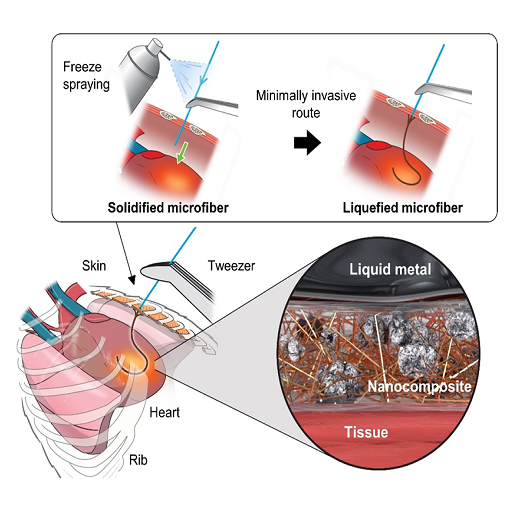
Needle-Like Multifunctional Biphasic Microfiber for Minimally Invasive Implantable Bioelectronics
Implantable bioelectronics has attracted significant attention in electroceuticals and clinical medicine for precise diagnosis and efficient treatment of target diseases. However, conventional rigid implantable devices face challenges such as poor tissue-device interface and unavoidable tissue damage during surgical implantation. Despite continuous efforts to utilize various soft materials to address such issues, their practical applications remain limited. Here, a needle-like stretchable microfiber composed of a phase-convertible liquid metal (LM) core and a multifunctional nanocomposite shell for minimally invasive soft bioelectronics is reported. The sharp tapered microfiber can be stiffened by freezing akin to a conventional needle to penetrate soft tissue with minimal incision. Once implanted in vivo where the LM melts, unlike conventional stiff needles, it regains soft mechanical properties, which facilitate a seamless tissue-device interface. The nanocomposite incorporating with functional nanomaterials exhibits both low impedance and the ability to detect physiological pH, providing biosensing and stimulation capabilities. The fluidic LM embedded in the nanocomposite shell enables high stretchability and strain-insensitive electrical properties. This multifunctional biphasic microfiber conforms to the surfaces of the stomach, muscle, and heart, offering a promising approach for electrophysiological recording, pH sensing, electrical stimulation, and radiofrequency ablation in vivo.
Advanced Materials, 36: 2404101, 2024
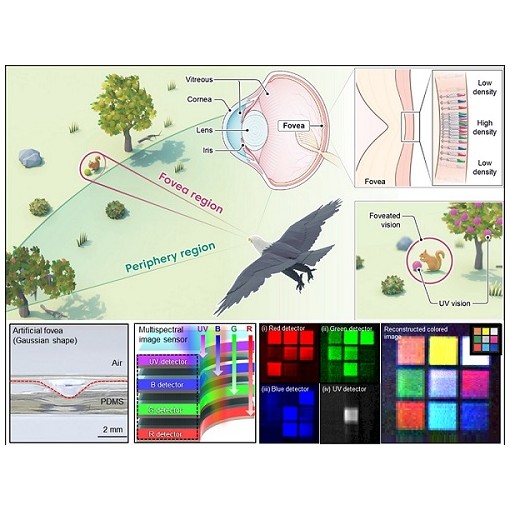
Avian Eye–inspired Perovskite Artificial Vision System for Foveated And Multispectral Imaging
Avian eyes have deep central foveae as a result of extensive evolution. Deep foveae efficiently refract incident light, creating a magnified image of the target object and making it easier to track object motion. These features are essential for detecting and tracking remote objects in dynamic environments. Furthermore, avian eyes respond to a wide spectrum of light, including visible and ultraviolet light, allowing them to efficiently distinguish the target object from complex backgrounds. Despite notable advances in artificial vision systems that mimic animal vision, the exceptional object detection and targeting capabilities of avian eyes via foveated and multispectral imaging remain underexplored. Here, we present an artificial vision system that capitalizes on these aspects of avian vision. We introduce an artificial fovea and vertically stacked perovskite photodetector arrays whose designs were optimized by theoretical simulations for the demonstration of foveated and multispectral imaging. The artificial vision system successfully identifies colored and mixed-color objects and detects remote objects through foveated imaging. The potential for use in uncrewed aerial vehicles that need to detect, track, and recognize distant targets in dynamic environments is also discussed. Our avian eye–inspired perovskite artificial vision system marks a notable advance in bioinspired artificial visions.
Science Robotics, 9: eadk6903, 2024
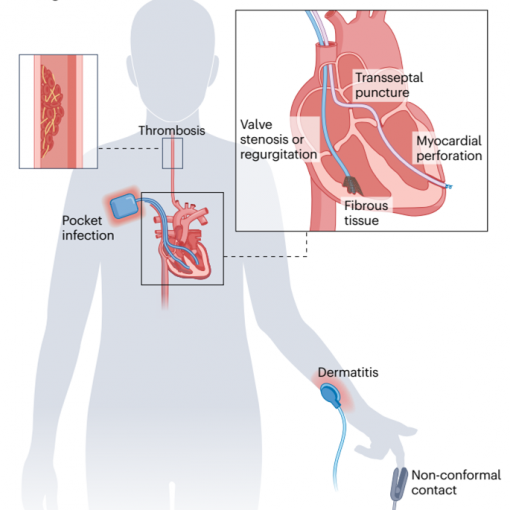
Soft Bioelectronics for the Management of Cardiovascular Diseases
The motions of the heart are regulated by electrophysiological signals, which can be monitored and altered by bioelectronic devices for the diagnosis and treatment of cardiovascular diseases. In particular, soft bioelectronic devices, composed of deformable and conductive materials, can be implanted or designed as wearable devices to enable conformal contact with heart tissue or the skin for real-time and precise diagnosis and treatment. In this Review, we discuss the design and materials of soft bioelectronic devices, highlighting their advantages, as compared with rigid bioelectronic devices, in cardiovascular disease management. We examine the engineering and applications of soft implantable bioelectronics, including cardiac mapping devices, cardiac stimulation devices and mechanically assisting devices, as well as wearable soft bioelectronics, such as blood oxygen saturation sensors, heart monitoring devices and transdermal drug delivery systems. Finally, we outline technical challenges and future opportunities for the clinical application of soft bioelectronic devices, such as a wireless power supply, optogenetic control of cardiac motion, bioadhesives for device–tissue interfaces and artificial intelligence-assisted data analysis.
Nature Reviews Bioengineering, 2: 8, 2024
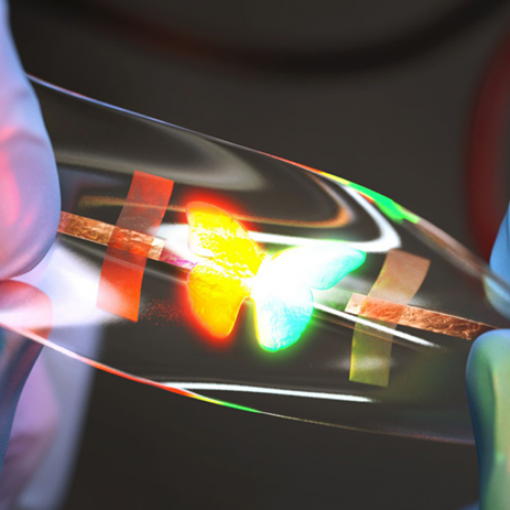
Intrinsically Stretchable Quantum Dot Light-Emitting Diodes
Stretchable displays that can change their shape and size under strain could be used to create displays with unconventional form factors. However, intrinsically stretchable light-emitting devices have poor luminous performance, such as low brightness. Here we show that intrinsically stretchable quantum dot light-emitting diodes (QLEDs) can be made using a mechanically soft and stretchable emissive layer consisting of a ternary nanocomposite of colloidal quantum dots, an elastomeric polymer and a charge transport polymer. The light-emitting layer maintains a nearly constant interparticle distance even under 50% strain, ensuring reliable operation of the QLED under stretching. The polymer-rich charge transport region at the bottom of the nanocomposite functions as a hole transport pathway to the embedded quantum dots. The QLEDs exhibit a turn-on voltage of 3.2 V and a maximum luminance of 15,170 cd m−2 at 6.2 V without loss of brightness, even when under 50% strain, and can be used to make stretchable full-colour passive-matrix QLED arrays.
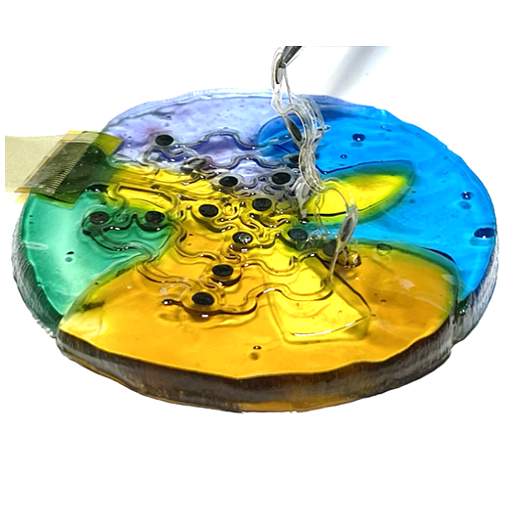
Low-Impedance Tissue-Device Interface using Homogeneously Conductive Hydrogels chemically bonded to stretchable bioelectronics
Stretchable bioelectronics has notably contributed to the advancement of continuous health monitoring and point-of-care type health care. However, microscale nonconformal contact and locally dehydrated interface limit performance, especially in dynamic environments. Therefore, hydrogels can be a promising interfacial material for the stretchable bioelectronics due to their unique advantages including tissue-like softness, water-rich property, and biocompatibility. However, there are still practical challenges in terms of their electrical performance, material homogeneity, and monolithic integration with stretchable devices. Here, we report the synthesis of a homogeneously conductive polyacrylamide hydrogel with an exceptionally low impedance (~21 ohms) and a reasonably high conductivity (~24 S/cm) by incorporating polyaniline-decorated poly(3,4-ethylenedioxythiophene:polystyrene). We also establish robust adhesion (interfacial toughness: ~296.7 J/m2) and reliable integration between the conductive hydrogel and the stretchable device through on-device polymerization as well as covalent and hydrogen bonding. These strategies enable the fabrication of a stretchable multichannel sensor array for the high-quality on-skin impedance and pH measurements under in vitro and in vivo circumstances.
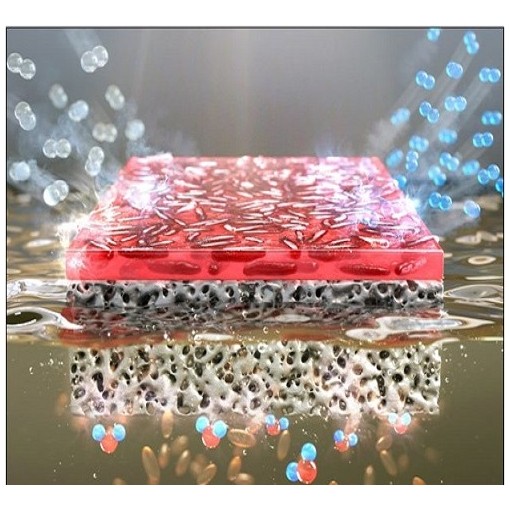
Highly Efficient Nitrogen-Fixing Microbial Hydrogel Device for Sustainable Solar Hydrogen Production
Conversion of sunlight and organic carbon substrates to sustainable energy sources through microbial metabolism has great potential for the renewable energy industry. Despite recent progress in microbial photosynthesis, the development of microbial platforms that warrant efficient and scalable fuel production remains in its infancy. Efficient transfer and retrieval of gaseous reactants and products to and from microbes are particular hurdles. Here, inspired by water lily leaves floating on water, a microbial device designed to operate at the air–water interface and facilitate concomitant supply of gaseous reactants, smooth capture of gaseous products, and efficient sunlight delivery is presented. The floatable device carrying Rhodopseudomonas parapalustris, of which nitrogen fixation activity is first determined through this study, exhibits a hydrogen production rate of 104 mmol h−1 m−2, which is 53 times higher than that of a conventional device placed at a depth of 2 cm in the medium. Furthermore, a scaled-up device with an area of 144 cm2 generates hydrogen at a high rate of 1.52 L h−1 m−2. Efficient nitrogen fixation and hydrogen generation, low fabrication cost, and mechanical durability corroborate the potential of the floatable microbial device toward practical and sustainable solar energy conversion.

Metal-like Stretchable Nanocomposite Using Locally-Bundled Nanowires for Skin-Mountable Devices
Stretchable conductive nanocomposites have been intensively studied for wearable bioelectronics. However, development of nanocomposites that simultaneously feature metal-like conductivity(> 100 000 S cm−1) and high stretchability (> 100%) for high-performance skin-mountable devices is still extremely challenging. Here a material strategy for such a nanocomposite is presented by using local bundling of silver nanowires stabilized with dual ligands (i.e., 1-propanethiols and 1-decanethiols). When the nanocomposite is solidified via solvent evaporation under a highly humid condition, the nanowires in the organic solution are bundled and stabilized. The resulting locally-bundled nanowires lower contact resistance while maintain their percolation network, leading to high conductivity. Dual ligands of 1-propanethiol and 1-decanethiol further boost up the conductivity. As a result, a nanocomposite with both high conductivity of ≈122,120 S cm−1 and high stretchability of ≈200% is obtained. Such superb electrical and mechanical properties are critical for various applications in skin-like electronics, and herein, a wearable thermo-stimulation device is demonstrated.

Floatable Photocatalytic Hydrogel Nanocomposites for Large-Scale Solar Hydrogen Production
Storing solar energy in chemical bonds aided by heterogeneous photocatalysis is desirable for sustainable energy conversion. Despite recent progress in designing highly active photocatalysts, inefficient solar energy and mass transfer, the instability of catalysts and reverse reactions impede their practical large-scale applications. Here we tackle these challenges by designing a floatable photocatalytic platform constructed from porous elastomer–hydrogel nanocomposites. The nanocomposites at the air–water interface feature efficient light delivery, facile supply of water and instantaneous gas separation. Consequently, a high hydrogen evolution rate of 163 mmol h–1 m–2 can be achieved using Pt/TiO2 cryoaerogel, even without forced convection. When fabricated in an area of 1 m2 and incorporated with economically feasible single-atom Cu/TiO2 photocatalysts, the nanocomposites produce 79.2 ml of hydrogen per day under natural sunlight. Furthermore, long-term stable hydrogen production in seawater and highly turbid water and photoreforming of polyethylene terephthalate demonstrate the potential of the nanocomposites as a commercially viable photocatalytic system.
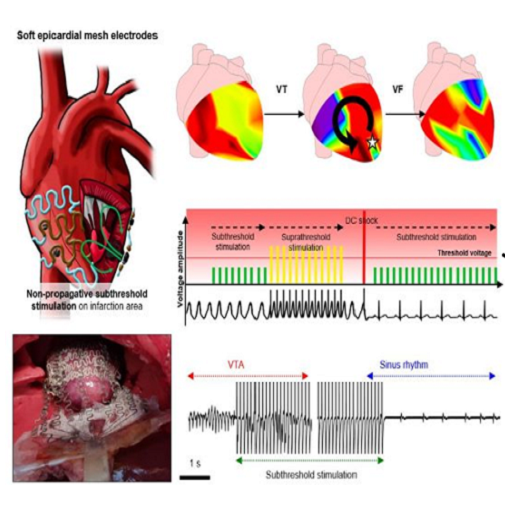
Ventricular tachyarrhythmia treatment and prevention by subthreshold stimulation with stretchable epicardial multichannel electrode array
The implantable cardioverter-defibrillator (ICD) is an effective method to prevent sudden cardiac death in high-risk patients. However, the transvenous lead is incompatible with large-area electrophysiological mapping and cannot accommodate selective multichannel precision stimulations. Moreover, it involves high-energy shocks, resulting in pain, myocardial damage, and recurrences of ventricular tachyarrhythmia (VTA). We present a method for VTA treatment based on subthreshold electrical stimulations using a stretchable epicardial multichannel electrode array, which does not disturb the normal contraction or electrical propagation of the ventricle. In rabbit models with myocardial infarction, the infarction was detected by mapping intracardiac electrograms with the stretchable epicardial multichannel electrode array. Then, VTAs could be terminated by sequential electrical stimuli from the epicardial multichannel electrode array beginning with low-energy subthreshold stimulations. Last, we used these subthreshold stimulations to prevent the occurrence of additional VTAs. The proposed protocol using the stretchable epicardial multichannel electrode array provides opportunities toward the development of innovative methods for painless ICD therapy.
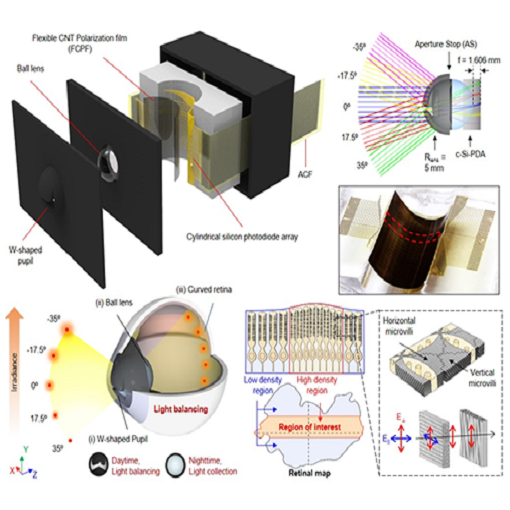
Cuttlefish Eye–Inspired Artificial Vision for High-quality Imaging under Uneven Illumination Conditions
With the rise of mobile robotics, including self-driving automobiles and drones, developing artificial vision for high-contrast and high-acuity imaging in vertically uneven illumination conditions has become an important goal. In such situations, balancing uneven illumination, improving image contrast for facile object detection, and achieving high visual acuity in the main visual fields are key requirements. Meanwhile, in nature, cuttlefish (genus Sepia) have evolved an eye optimized for vertically uneven illumination conditions, which consists of a W-shaped pupil, a single spherical lens, and a curved retina with a high-density photoreceptor arrangement and polarized light sensitivity. Here, inspired by the cuttlefish eye, we report an artificial vision system consisting of a W-shaped pupil, a single ball lens, a surface-integrated flexible polarizer, and a cylindrical silicon photodiode array with a locally densified pixel arrangement. The W-shaped pupil integrated on the ball lens balances vertically uneven illumination, and the cylindrical silicon photodiode array integrated with the flexible polarizer enables high-contrast and high-acuity imaging.
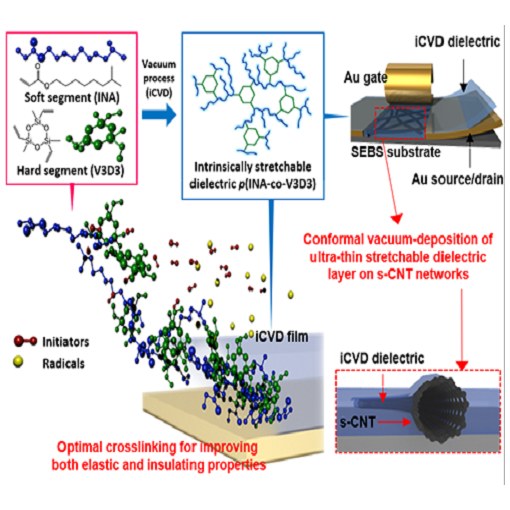
A vacuum-deposited polymer dielectric for wafer-scale stretchable electronics
Despite recent advances in materials and fabrication technologies, the development of intrinsically stretchable electronic devices with large-area uniformity, low power consumption and performance comparable with conventional rigid devices remains challenging. A key limitation is the absence of an elastic dielectric material that can be thin and uniform over large areas as well as offer robust insulating properties and high mechanical and chemical stability. Here we show that a vacuum-deposited elastic polymer layer can be used as the gate dielectric in stretchy field-effect transistors with carbon nanotube channels and microcracked gold electrodes. The polymer dielectric layer has high insulation properties (at a thickness below 200 nm), high stability and large-area uniformity. An 8-inch wafer array of the stretchable carbon nanotube transistors exhibits good uniformity in their electrical performance and can maintain their performance after 1,000 stretching cycles at 40% strain. We use the transistors to construct stretchy inverters and logic gates that can function under applied strains of up to 40%.
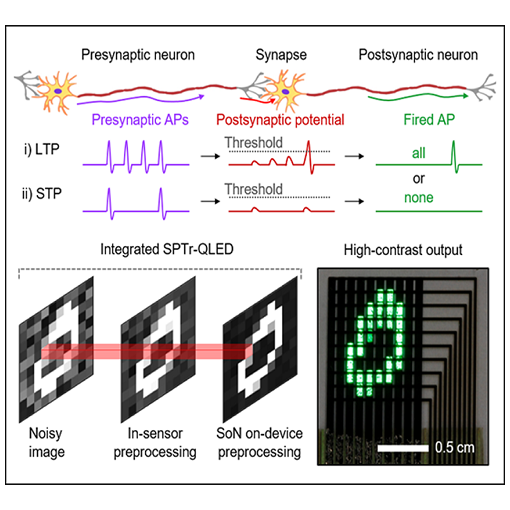
Integration of synaptic phototransistors and quantum dot light-emitting diodes for visualization and recognition of UV patterns
Synaptic photodetectors exhibit photon-triggered synaptic plasticity, which thus can improve the image recognition rate by enhancing the image contrast. However, still, the visualization and recognition of invisible ultraviolet (UV) patterns are challenging, owing to intense background noise. Here, inspired by all-or-none potentiation of synapse, we develop an integrated device of synaptic phototransistors (SPTrs) and quantum dot light-emitting diodes (QLEDs), facilitating noise reduction and visualization of UV patterns through on-device preprocessing. The SPTrs convert noisy UV inputs into a weighted photocurrent, which is applied to the QLEDs as a voltage input through an external current-voltage–converting circuit. The threshold switching characteristics of the QLEDs result in amplified current and visible illumination by the suprathreshold input voltage or nearly zero current and no visible illumination by the input voltage below the threshold. The preprocessing of image data with the SPTr-QLED can amplify the image contrast, which is helpful for high-accuracy image recognition.

An amphibious artificial vision system with a panoramic visual field
Biological visual systems have inspired the development of various artificial visual systems including those based on human eyes (terrestrial environment), insect eyes (terrestrial environment) and fish eyes (aquatic environment). However, attempts to develop systems for both terrestrial and aquatic environments remain limited, and bioinspired electronic eyes are restricted in their maximum field of view to a hemispherical field of view (around 180°). Here we report the development of an amphibious artificial vision system with a panoramic visual field inspired by the functional and anatomical structure of the compound eyes of a fiddler crab. We integrate a microlens array with a graded refractive index and a flexible comb-shaped silicon photodiode array on a spherical structure. The microlenses have a flat surface and maintain their focal length regardless of changes in the external refractive index between air and water. The comb-shaped image sensor arrays on the spherical substrate exhibit an extremely wide field of view covering almost the entire spherical geometry. We illustrate the capabilities of our system via optical simulations and imaging demonstrations in both air and water.
Nature Electronics, 5: 452, 2022
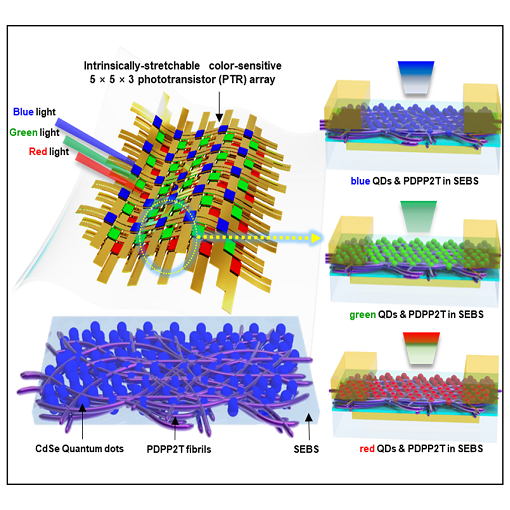
Stretchable colour-sensitive quantum dot nanocomposites for shape-tunable multiplexed phototransistor arrays
High-performance photodetecting materials with intrinsic stretchability and colour sensitivity are key requirements for the development of shape-tunable phototransistor arrays. Another challenge is the proper compensation of optical aberrations and noises generated by mechanical deformation and fatigue accumulation in a shape-tunable phototransistor array. Here we report rational material design and device fabrication strategies for an intrinsically stretchable, multispectral and multiplexed 5 × 5 × 3 phototransistor array. Specifically, a unique spatial distribution of size-tuned quantum dots, blended in a semiconducting polymer within an elastomeric matrix, was formed owing to surface energy mismatch, leading to highly efficient charge transfer. Such intrinsically stretchable quantum-dot-based semiconducting nanocomposites enable the shape-tunable and colour-sensitive capabilities of the phototransistor array. We use a deep neural network algorithm for compensating optical aberrations and noises, which aids the precise detection of specific colour patterns (for example, red, green and blue patterns) both under its flat state and hemispherically curved state (radius of curvature of 18.4 mm).

Wide-range robust wireless power transfer using heterogeneously coupled and flippable neutrals in parity-time symmetry
Recently, stationary wireless power transfer (WPT) has been widely adopted in commercial devices. However, the current WPT configuration is limited in its operational area and susceptible to operating condition changes, impeding its applications for dynamic environments. To overcome the limitations, we propose a WPT system with laterally aligned neutral elements in parity-time (PT) symmetry, which can widen the operational area with the number of neutrals N. Compared to the conventional multiple-input–single-output WPT, the dimension of system complexity is substantially reduced from R × CN to RN+1 because the neutral amplitudes are simply controlled by coupling capacitors. The operational frequency is automatically adjusted to a real eigenvalue of the PT-symmetric system to achieve high voltage gain and efficiency, making the system robust. The performance of the system calculated by the coupled-mode theory was experimentally verified with rigid and flexible types of receivers, confirming its potential in both industrial and biomedical electronics.
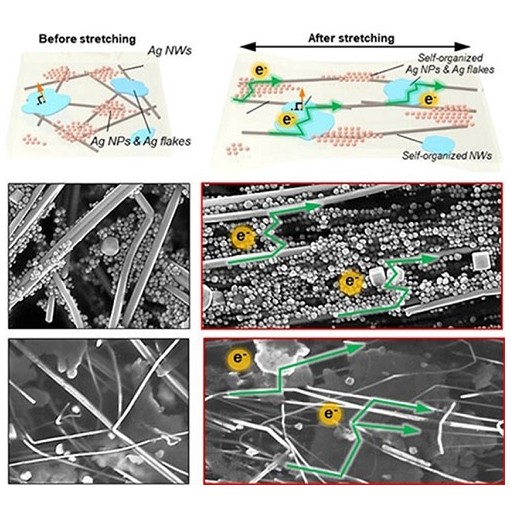
Adaptive self-organization of nanomaterials enables strain-insensitive resistance of stretchable metallic nanocomposites
Highly conductive and stretchable nanocomposites are promising material candidates for skin electronics. However, the resistance of stretchable metallic nanocomposites highly depends on external strains, often deteriorating the performance of fabricated electronic devices. Here, a material strategy for the highly conductive and stretchable nanocomposites comprising metal nanomaterials of various dimensions and a viscoelastic block-copolymer matrix is presented. The resistance of the nanocomposites can be well retained under skin deformations (<50% strain). It is demonstrated that silver nanomaterials can self-organize inside the viscoelastic media in response to external strain when their surface is conjugated with 1-decanethiol. Distinct self-organization behaviors associated with nanomaterial dimensions and strain conditions are found. Adopting the optimum composition of 0D/1D/2D silver nanomaterials can render the resistance of the nanocomposites insensitive to uniaxial or biaxial strains. As a result, the resistance can be maintained with a variance of < 1% during 1000 stretching cycles under uniaxial and biaxial strains of <50% while a high conductivity of ≈31 000 S cm−1 is achieved.
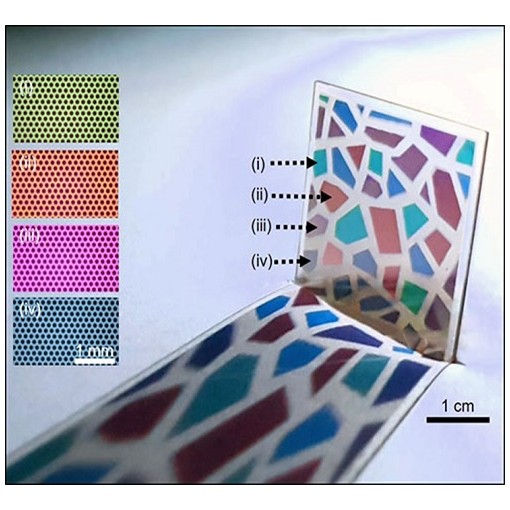
Perovskite microcells fabricated using swelling-induced crack propagation for colored solar windows
Perovskite microcells have a great potential to be applied to diverse types of optoelectronic devices including light-emitting diodes, photodetectors, and solar cells. Although several perovskite fabrication methods have been researched, perovskite microcells without a significant efficiency drop during the patterning and fabrication process could not be developed yet. We herein report the fabrication of high-efficiency perovskite microcells using swelling-induced crack propagation and the application of the microcells to colored solar windows. The key procedure is a swelling-induced lift-off process that leads to patterned perovskite films with high-quality interfaces. Thus, a power conversion efficiency (PCE) of 20.1 % could be achieved with the perovskite microcell, which is nearly same as the PCE of our unpatterned perovskite photovoltaic device (PV). The semi-transparent PV based on microcells exhibited a light utilization efficiency of 4.67 and a color rendering index of 97.5 %. The metal–insulator–metal structure deposited on the semi-transparent PV enabled to fabricate solar windows with vivid colors and high color purity.
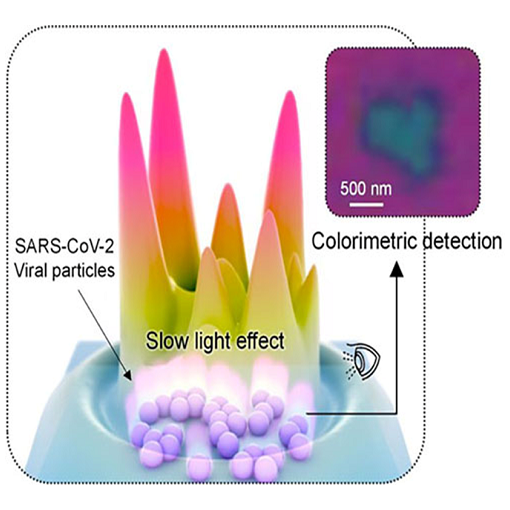
Gires-Tournois immunoassay platform for label-free bright-field imaging and facile quantification of bioparticles
Bright-field imaging of nanoscale bioparticles is a challenging task for optical microscopy because the light–matter interactions of bioparticles are weak on conventional surfaces due to their low refractive index and small size. Alternatively, advanced imaging techniques, including near-field microscopy and phase microscopy, have enabled visualization and quantification of the bioparticles, but they require assistance of sophisticated/customized systems and post-processing with complex established algorithms. Here, a simple and fast immunoassay device, Gires–Tournois immunoassay platform (GTIP) is presented, which provides unique color dynamics in response to optical environment changes and thus enables the label-free bright-field imaging and facile quantification of bioparticles using conventional optical microscopy. Bioparticles on GTIP slow down the velocity of reflected light, leading to vivid color change according to the local particle density and maximizing chromatic contrast for high spatial distinguishability. The particle distribution and density on the surface of the resonator are readily analyzed through 2D raster-scanning-based chromaticity analysis. GTIP offers multiscale sensing capability for target analytes that possess different refractive indices and sizes.

Three-dimensional foldable quantum dot light-emitting diodes
Flexible light-emitting devices that can transform from two-dimensional to three-dimensional (3D) forms could be of use in the development of next-generation displays. Various approaches for converting two-dimensional structures into 3D architectures have been explored, including origami methods that rely on folding along lines in which a structure has been thinned. But the fabrication of foldable 3D light-emitting devices remains challenging due, in particular, to the lack of a practical method for patterning the folding lines. Here we show that 3D foldable quantum dot light-emitting diodes (QLEDs) can be created using laser patterning and metal etch-stop layers with customized ablation thresholds. The approach allows etching to be limited to selected layers of the multilayered QLEDs, and it can be precisely tuned by using alloy-type etch-stop layers. The approach can be used to create QLED architectures with extremely small bending radii (0.047 mm), and we illustrate its capabilities by fabricating a 3D foldable passive matrix array of QLEDs that can display letters and numbers.
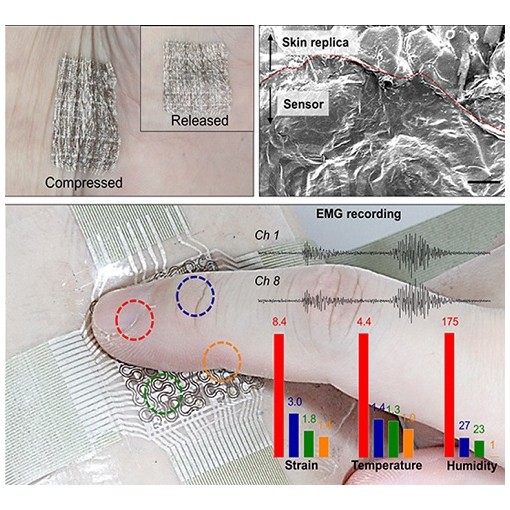
Highly conductive and elastic nanomembrane for skin electronics
Skin electronics require stretchable conductors that satisfy metallike conductivity, high stretchability, ultrathin thickness, and facile patternability, but achieving these characteristics simultaneously is challenging. We present a float assembly method to fabricate a nanomembrane that meets all these requirements. The method enables a compact assembly of nanomaterials at the water–oil interface and their partial embedment in an ultrathin elastomer membrane, which can distribute the applied strain in the elastomer membrane and thus lead to a high elasticity even with the high loading of the nanomaterials. Furthermore, the structure allows cold welding and bilayer stacking, resulting in high conductivity. These properties are preserved even after high-resolution patterning by using photolithography. A multifunctional epidermal sensor array can be fabricated with the patterned nanomembranes.
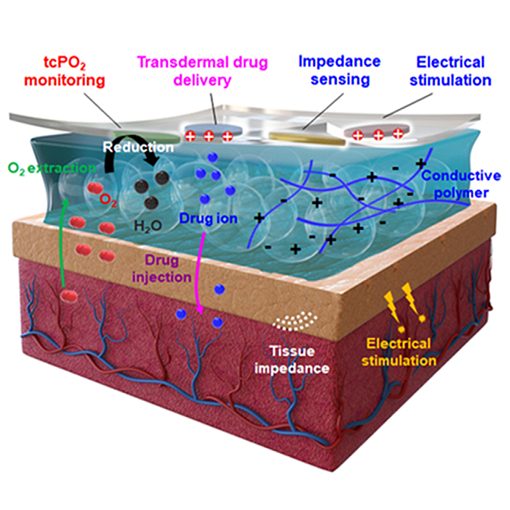
Tissue-like skin-device interface for wearable bioelectronics by using ultrasoft, mass-permeable, and low-impedance hydrogels
Hydrogels consist of a cross-linked porous polymer network and water molecules occupying the interspace between the polymer chains. Therefore, hydrogels are soft and moisturized, with mechanical structures and physical properties similar to those of human tissue. Such hydrogels have a potential to turn the microscale gap between wearable devices and human skin into a tissue-like space. Here, we present material and device strategies to form a tissue-like, quasi-solid interface between wearable bioelectronics and human skin. The key material is an ultrathin type of functionalized hydrogel that shows unusual features of high mass-permeability and low impedance. The functionalized hydrogel acted as a liquid electrolyte on the skin and formed an extremely conformal and low-impedance interface for wearable electrochemical biosensors and electrical stimulators. Furthermore, its porous structure and ultrathin thickness facilitated the efficient transport of target molecules through the interface. Therefore, this functionalized hydrogel can maximize the performance of various wearable bioelectronics.
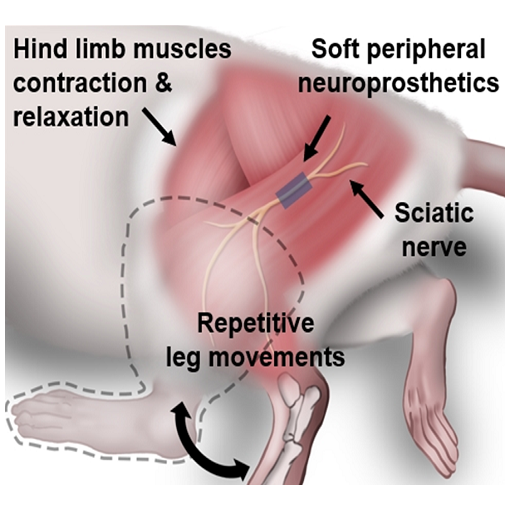
Durable and Fatigue‐Resistant Soft Peripheral Neuroprosthetics for In Vivo Bidirectional Signaling
Soft neuroprosthetics that monitor signals from sensory neurons and deliver motor information can potentially replace damaged nerves. However, achieving long-term stability of devices interfacing peripheral nerves is challenging, since dynamic mechanical deformations in peripheral nerves cause material degradation in devices. Here, a durable and fatigue-resistant soft neuroprosthetic device is reported for bidirectional signaling on peripheral nerves. The neuroprosthetic device is made of a nanocomposite of gold nanoshell (AuNS)-coated silver (Ag) flakes dispersed in a tough, stretchable, and self-healing polymer (SHP). The dynamic self-healing property of the nanocomposite allows the percolation network of AuNS-coated flakes to rebuild after degradation. Therefore, its degraded electrical and mechanical performance by repetitive, irregular, and intense deformations at the device–nerve interface can be spontaneously self-recovered. When the device is implanted on a rat sciatic nerve, stable bidirectional signaling is obtained for over 5 weeks. Neural signals collected from a live walking rat using these neuroprosthetics are analyzed by a deep neural network to predict the joint position precisely. This result demonstrates that durable soft neuroprosthetics can facilitate collection and analysis of large-sized in vivo data for solving challenges in neurological disorders.

A Biodegradable Secondary Battery and its Biodegradation Mechanism for Eco-Friendly Energy-Storage Systems
The production of rechargeable batteries is rapidly expanding, and there are going to be new challenges in the near future about how the potential environmental impact caused by the disposal of the large volume of the used batteries can be minimized. Herein, a novel strategy is proposed to address these concerns by applying biodegradable device technology. An eco-friendly and biodegradable sodium-ion secondary battery (SIB) is developed through extensive material screening followed by the synthesis of biodegradable electrodes and their seamless assembly with an unconventional biodegradable separator, electrolyte, and package. Each battery component decomposes in nature into non-toxic compounds or elements via hydrolysis and/or fungal degradation, with all of the biodegradation products naturally abundant and eco-friendly. Detailed biodegradation mechanisms and toxicity influence of each component on living organisms are determined. In addition, this new SIB delivers performance comparable to that of conventional non-degradable SIBs. The strategy and findings suggest a novel eco-friendly biodegradable paradigm for large-scale rechargeable battery systems.
Advanced Materials, 33: 2004902, 2021
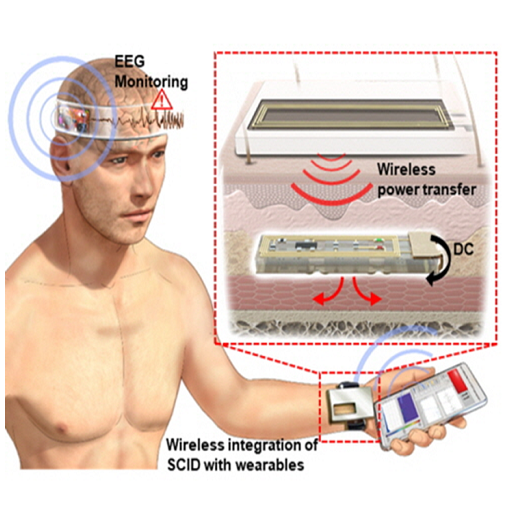
Soft implantable drug delivery device integrated wirelessly with wearable devices to treat fatal seizures
Personalized biomedical devices have enormous potential to solve clinical challenges in urgent medical situations. Despite this potential, a device for in situ treatment of fatal seizures using pharmaceutical methods has not been developed yet. Here, we present a novel treatment system for neurological medical emergencies, such as status epilepticus, a fatal epileptic condition that requires immediate treatment, using a soft implantable drug delivery device (SID). The SID is integrated wirelessly with wearable devices for monitoring electroencephalography signals and triggering subcutaneous drug release through wireless voltage induction. Because of the wireless integration, bulky rigid components such as sensors, batteries, and electronic circuits can be moved from the SID to wearables, and thus, the mechanical softness and miniaturization of the SID are achieved. The efficacy of the prompt treatment could be demonstrated with animal experiments in vivo, in which brain damages were reduced and survival rates were increased.
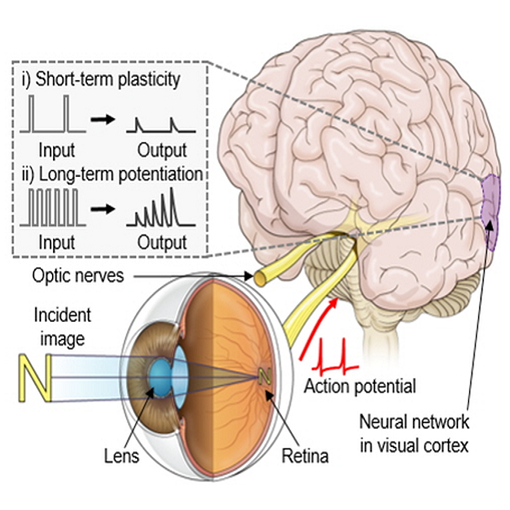
Curved Neuromorphic Image Sensor Array Using a MoS2-organic Heterostructure Inspired by the Human Visual Recognition System
Conventional imaging and recognition systems require an extensive amount of data storage, pre-processing, and chip-to-chip communications as well as aberration-proof light focusing with multiple lenses for recognizing an object from massive optical inputs. This is because separate chips (i.e., flat image sensor array, memory device, and CPU) in conjunction with complicated optics should capture, store, and process massive image information independently. In contrast, human vision employs a highly efficient imaging and recognition process. Here, inspired by the human visual recognition system, we present a novel imaging device for efficient image acquisition and data pre-processing by conferring the neuromorphic data processing function on a curved image sensor array. The curved neuromorphic image sensor array is based on a heterostructure of MoS2 and poly(1,3,5-trimethyl-1,3,5-trivinyl cyclotrisiloxane). The curved neuromorphic image sensor array features photon-triggered synaptic plasticity owing to its quasi-linear time-dependent photocurrent generation and prolonged photocurrent decay, originated from charge trapping in the MoS2-organic vertical stack. The curved neuromorphic image sensor array integrated with a plano-convex lens derives a pre-processed image from a set of noisy optical inputs without redundant data storage, processing, and communications as well as without complex optics. The proposed imaging device can substantially improve efficiency of the image acquisition and recognition process, a step forward to the next generation machine vision.
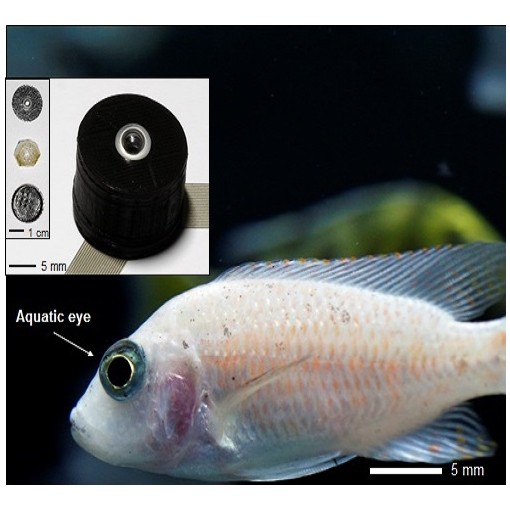
An Aquatic-vision-inspired Camera Based on a Monocentric Lens and a Silicon Nanorod Photodiode Array
Conventional wide-field-of-view cameras consist of multi-lens optics and flat image sensor arrays, which makes them bulky and heavy. As a result, they are poorly suited to advanced mobile applications such as drones and autonomous vehicles. In nature, the eyes of aquatic animals consist of a single spherical lens and a highly sensitive hemispherical retina, an approach that could be beneficial in the development of synthetic wide-field-of-view imaging systems. Here, we report an aquatic-vision-inspired camera that consists of a single monocentric lens and a hemispherical silicon nanorod photodiode array. The imaging system features a wide field of view, miniaturized design, low optical aberration, deep depth of field and simple visual accommodation. Furthermore, under vignetting, the photodiode array enables high-quality panoramic imaging due to the enhanced photodetection properties of the silicon nanorod photodiodes.

Flexible, Sticky, and Biodegradable Wireless Device for Drug Delivery to Brain Tumors
Implantation of biodegradable wafers near the brain surgery site to deliver anti-cancer agents which target residual tumor cells by bypassing the blood-brain barrier has been a promising method for brain tumor treatment. However, further improvement in the prognosis is still necessary. We herein present novel materials and device technologies for drug delivery to brain tumors, i.e., a flexible, sticky, and biodegradable drug-loaded patch integrated with wireless electronics for controlled intracranial drug delivery through mild-thermic actuation. The flexible and bifacially-designed sticky/hydrophobic device allows conformal adhesion on the brain surgery site and provides spatially-controlled and temporarily-extended drug delivery to brain tumors while minimizing unintended drug leakage to the cerebrospinal fluid. Biodegradation of the entire device minimizes potential neurological side-effects. Application of the device to the mouse model confirms tumor volume suppression and improved survival rate. Demonstration in a large animal model (canine model) exhibited its potential for human application.
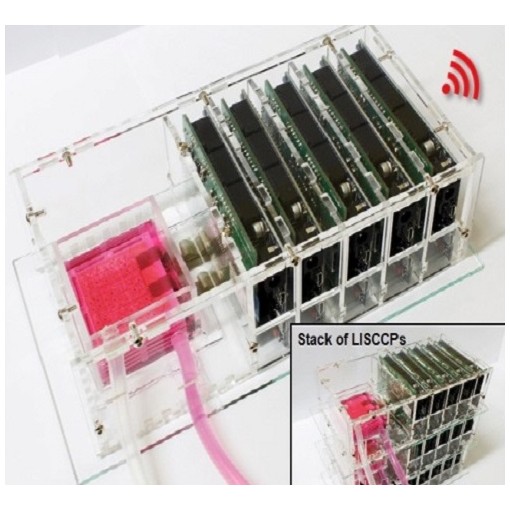
Large Scale and Integrated Platform for Digital Mass Culture of Anchorage Dependent Cells
Industrial applications of anchorage-dependent cells require large-scale cell culture with multifunctional monitoring of culture conditions and control of cell behaviour. Here, we introduce a large-scale, integrated, and smart cell-culture platform (LISCCP) that facilitates digital mass culture of anchorage-dependent cells. LISCCP is devised through large-scale integration of ultrathin sensors and stimulator arrays in multiple layers. LISCCP provides real-time, 3D, and multimodal monitoring and localized control of the cultured cells, which thereby allows minimizing operation labour and maximizing cell culture performance. Wireless integration of multiple LISCCPs across multiple incubators further amplifies the culture scale and enables digital monitoring and local control of numerous culture layers, making the large-scale culture more efficient. Thus, LISCCP can transform conventional labour-intensive and high-cost cell cultures into efficient digital mass cell cultures. This platform could be useful for industrial applications of cell cultures such as in vitro toxicity testing of drugs and cosmetics and clinical scale production of cells for cell therapy.
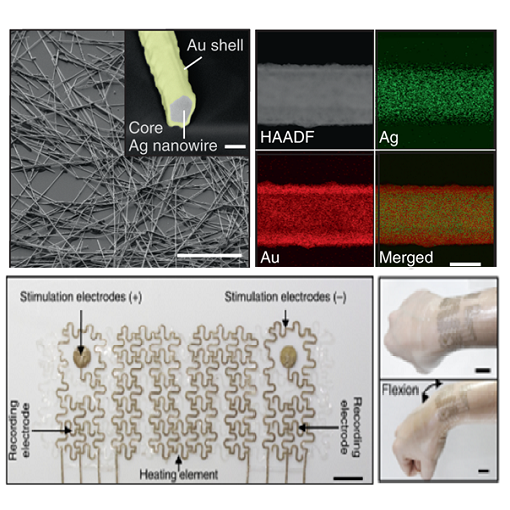
Highly Conductive, Stretchable and Biocompatible Ag-Au core-sheath Nanowire Composite for Wearable and Implantable Bioelectronics
Wearable and implantable devices require conductive, stretchable and biocompatible materials. However, obtaining composites that simultaneously fulfil these requirements is challenging due to a trade-off between conductivity and stretchability. Here, we report on Ag–Au nanocomposites composed of ultralong gold-coated silver nanowires in an elastomeric block-copolymer matrix. Owing to the high aspect ratio and percolation network of the Ag–Au nanowires, the nanocomposites exhibit an optimized conductivity of 41,850 S cm−1 (maximum of 72,600 S cm−1). Phase separation in the Ag–Au nanocomposite during the solvent-drying process generates a microstructure that yields an optimized stretchability of 266% (maximum of 840%). The thick gold sheath deposited on the silver nanowire surface prevents oxidation and silver ion leaching, making the composite biocompatible and highly conductive. Using the nanocomposite, we successfully fabricate wearable and implantable soft bioelectronic devices that can be conformally integrated with human skin and swine heart for continuous electrophysiological recording, and electrical and thermal stimulation.

Extremely Vivid, Highly Transparent, and Ultrathin Quantum Dot Light-Emitting Diodes
Displaying information on transparent screens offers new opportunities in next-generation electronics, such as augmented reality devices, smart surgical glasses, and smart windows. Outstanding luminance and transparency are essential for such “see-through” displays to show vivid images over clear background view. Here transparent quantum dot light-emitting diodes (Tr-QLEDs) are reported with high brightness (bottom: ≈43 000 cd m−2, top: ≈30 000 cd m−2, total: ≈73 000 cd m−2 at 9 V), excellent transmittance (90% at 550 nm, 84% over visible range), and an ultrathin form factor (≈2.7 µm thickness). These superb characteristics are accomplished by novel electron transport layers (ETLs) and engineered quantum dots (QDs). The ETLs, ZnO nanoparticle assemblies with ultrathin alumina overlayers, dramatically enhance durability of active layers, and balance electron/hole injection into QDs, which prevents nonradiative recombination processes. In addition, the QD structure is further optimized to fully exploit the device architecture. The ultrathin nature of Tr-QLEDs allows their conformal integration on various shaped objects. Finally, the high resolution patterning of red, green, and blue Tr-QLEDs (513 pixels in.−1) shows the potential of the full-color transparent display.

Human eye-inspired soft optoelectronic device using high-density MoS2-graphene curved image sensor array
Soft bioelectronic devices provide new opportunities for next-generation implantable devices owing to their soft mechanical nature that leads to minimal tissue damages and immune responses. However, a soft form of the implantable optoelectronic device for optical sensing and retinal stimulation has not been developed yet because of the bulkiness and rigidity of conventional imaging modules and their composing materials. Here, we describe a high-density and hemispherically curved image sensor array that leverages the atomically thin MoS2-graphene heterostructure and strain-releasing device designs. The hemispherically curved image sensor array exhibits infrared blindness and successfully acquires pixelated optical signals. We corroborate the validity of the proposed soft materials and ultrathin device designs through theoretical modeling and finite element analysis. Then, we propose the ultrathin hemispherically curved image sensor array as a promising imaging element in the soft retinal implant. The CurvIS array is applied as a human eye-inspired soft implantable optoelectronic device that can detect optical signals and apply programmed electrical stimulation to optic nerves with minimum mechanical side effects to the retina.
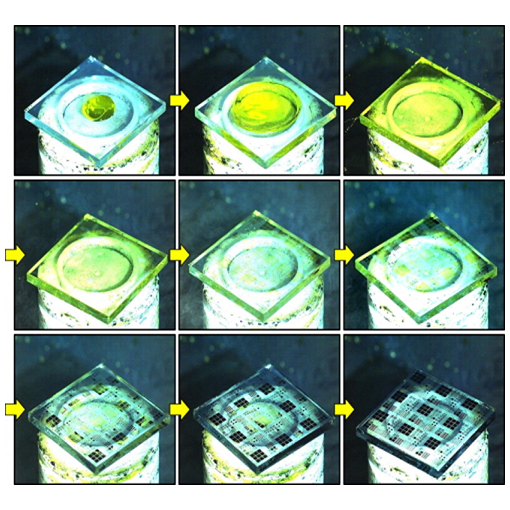
High-Resolution Spin-on-Patterning of Perovskite Thin Films for a Multiplexed Image Sensor Array
Inorganic–organic hybrid perovskite thin films have attracted significant attention as an alternative to silicon in photon-absorbing devices mainly because of their superb optoelectronic properties. However, high-definition patterning of perovskite thin films, which is important for fabrication of the image sensor array, is hardly accomplished owing to their extreme instability in general photolithographic solvents. Here, a novel patterning process for perovskite thin films is described: the high-resolution spin-on-patterning (SoP) process. This fast and facile process is compatible with a variety of spin-coated perovskite materials and perovskite deposition techniques. The SoP process is successfully applied to develop a high-performance, ultrathin, and deformable perovskite-on-silicon multiplexed image sensor array, paving the road toward next-generation image sensor arrays.
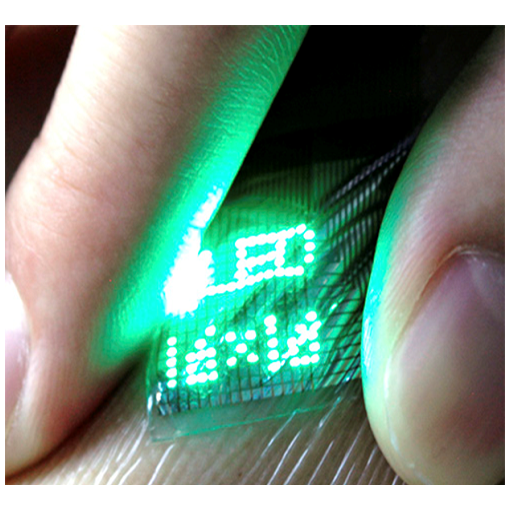
Ultrathin Quantum Dot Display Integrated with Wearable Electronics
An ultrathin skin-attachable display is a critical component for an information output port in next-generation wearable electronics. In this regard, quantum dot (QD) light-emitting diodes (QLEDs) offer unique and attractive characteristics for future displays, including high color purity with narrow bandwidths, high electroluminescence (EL) brightness at low operating voltages, and easy processability. Here, ultrathin QLED displays that utilize a passive matrix to address individual pixels are reported. The ultrathin thickness (≈5.5 µm) of the QLED display enables its conformal contact with the wearer's skin and prevents its failure under vigorous mechanical deformation. QDs with relatively thick shells are employed to improve EL characteristics (brightness up to 44 719 cd m−2 at 9 V, which is the record highest among wearable LEDs reported to date) by suppressing the nonradiative recombination. Various patterns, including letters, numbers, and symbols can be successfully visualized on the skin-mounted QLED display. Furthermore, the combination of the ultrathin QLED display with flexible driving circuits and wearable sensors results in a fully integrated QLED display that can directly show sensor data.
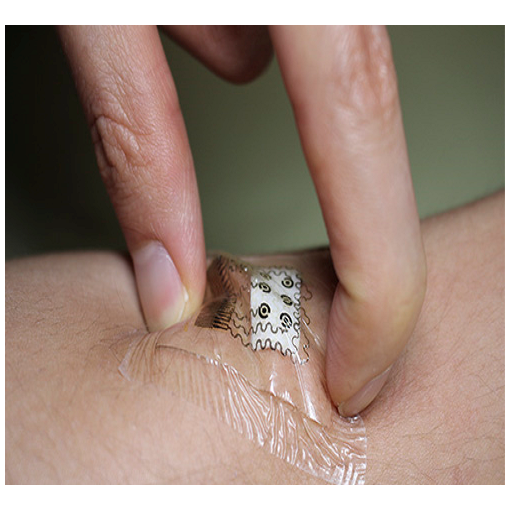
Wearable/disposable Sweat-based Glucose Monitoring Device with Multistage Transdermal Drug Delivery Module
Electrochemical analysis of sweat using soft bioelectronics on human skin provides a new route for noninvasive glucose monitoring without painful blood collection. However, sweat-based glucose sensing still faces many challenges, such as difficulty in sweat collection, activity variation of glucose oxidase due to lactic acid secretion and ambient temperature changes, and delamination of the enzyme when exposed to mechanical friction and skin deformation. Precise point-of-care therapy in response to the measured glucose levels is still very challenging. We present a wearable/disposable sweat-based glucose monitoring device integrated with a feedback transdermal drug delivery module. Careful multilayer patch design and miniaturization of sensors increase the efficiency of the sweat collection and sensing process. Multimodal glucose sensing, as well as its real-time correction based on pH, temperature, and humidity measurements, maximizes the accuracy of the sensing. The minimal layout design of the same sensors also enables a strip-type disposable device. Drugs for the feedback transdermal therapy are loaded on two different temperature-responsive phase change nanoparticles. These nanoparticles are embedded in hyaluronic acid hydrogel microneedles, which are additionally coated with phase change materials. This enables multistage, spatially patterned, and precisely controlled drug release in response to the patient’s glucose level. The system provides a novel closed-loop solution for the noninvasive sweat-based management of diabetes mellitus.
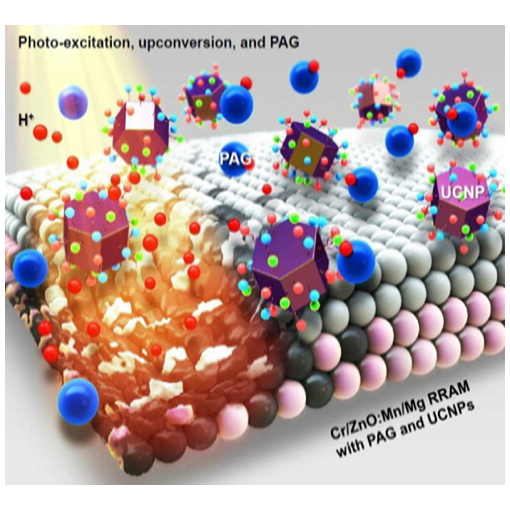
Ultra-Wideband Multi-Dye-Sensitized Upconverting Nanoparticles for Information Security Application
Multi-dye-sensitized upconverting nanoparticles (UCNPs), which harvest photons of wide wavelength range (450–975 nm) are designed and synthesized. The UCNPs embedded in a photo-acid generating layer are integrated on destructible nonvolatile resistive memory device. Upon illumination of light, the system permanently erases stored data, achieving enhanced information security.
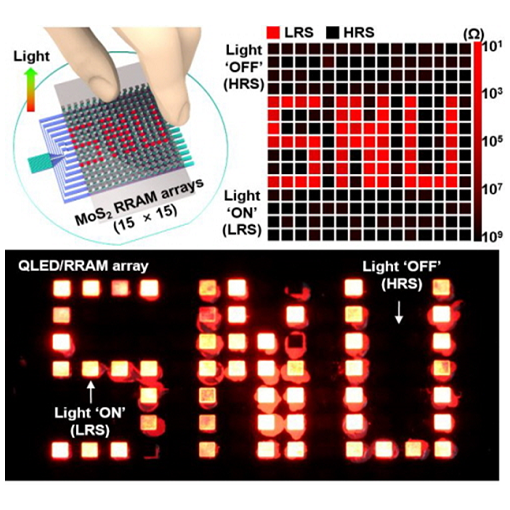
Colloidal Synthesis of Uniform-Sized Molybdenum Disulfide Nanosheets for Wafer-Scale Flexible Nonvolatile Memory
Large-scale colloidal synthesis and integration of uniform-sized molybdenum disulfide (MoS2) nanosheets for a flexible resistive random access memory (RRAM) array are presented. RRAM using MoS2 nanosheets shows a ≈10 000 times higher on/off ratio than that based on exfoliated MoS2. The good uniformity of the MoS2 nanosheets allows wafer-scale system integration of the RRAM array with pressure sensors and quantum-dot light-emitting diodes.
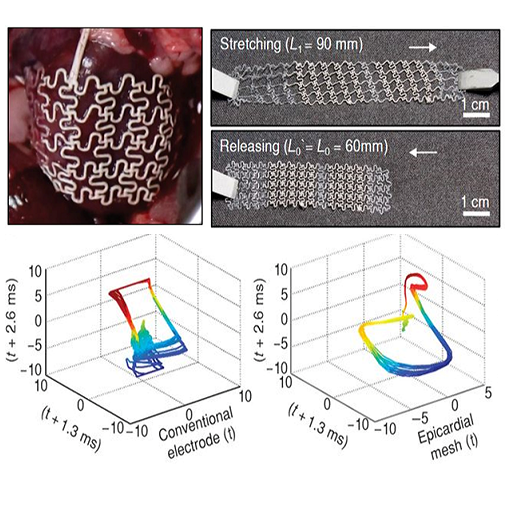
Electromechanical Cardioplasty Using A Wrapped Elasto-conductive Epicardial Mesh
Heart failure remains a major public health concern with a 5-year mortality rate higher than that of most cancers. Myocardial disease in heart failure is frequently accompanied by impairment of the specialized electrical conduction system and myocardium. We introduce an epicardial mesh made of electrically conductive and mechanically elastic material, to resemble the innate cardiac tissue and confer cardiac conduction system function, to enable electromechanical cardioplasty. Our epicardium-like substrate mechanically integrated with the heart and acted as a structural element of cardiac chambers. The epicardial device was designed with elastic properties nearly identical to the epicardial tissue itself and was able to detect electrical signals reliably on the moving rat heart without impeding diastolic function 8 weeks after induced myocardial infarction. Synchronized electrical stimulation over the ventricles by the epicardial mesh with the high conductivity of 11,210 S/cm shortened total ventricular activation time, reduced inherent wall stress, and improved several measures of systolic function including increases of 51% in fractional shortening, ~90% in radial strain, and 42% in contractility. The epicardial mesh was also capable of delivering an electrical shock to terminate a ventricular tachyarrhythmia in rodents. Electromechanical cardioplasty using an epicardial mesh is a new pathway toward reconstruction of the cardiac tissue and its specialized functions.
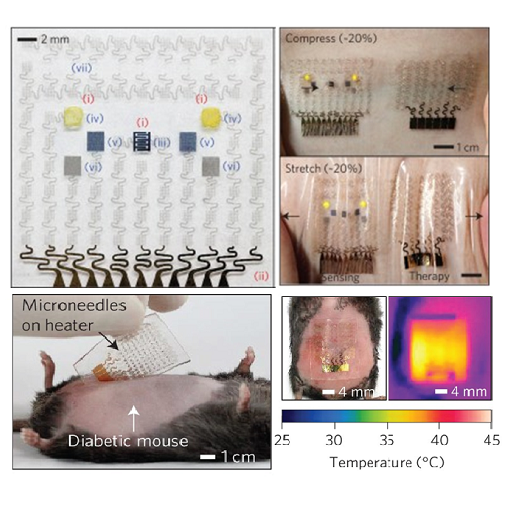
A Graphene-based Electrochemical Device with Thermoresponsive Microneedles for Diabetes Monitoring and Therapy
Owing to its high carrier mobility, conductivity, flexibility and optical transparency, graphene is a versatile material in micro- and macroelectronics. However, the low density of electrochemically active defects in graphene synthesized by chemical vapour deposition limits its application in biosensing. Here, we show that graphene doped with gold and combined with a gold mesh has improved electrochemical activity over bare graphene, sufficient to form a wearable patch for sweat-based diabetes monitoring and feedback therapy. The stretchable device features a serpentine bilayer of gold mesh and gold-doped graphene that forms an efficient electrochemical interface for the stable transfer of electrical signals. The patch consists of a heater, temperature, humidity, glucose and pH sensors and polymeric microneedles that can be thermally activated to deliver drugs transcutaneously. We show that the patch can be thermally actuated to deliver Metformin and reduce blood glucose levels in diabetic mice.

A Wearable Multiplexed Silicon Nonvolatile Memory Array Using Nanocrystal Charge Confinement
Strategies for efficient charge confinement in nanocrystal floating gates to realize high-performance memory devices have been investigated intensively. However, few studies have reported nanoscale experimental validations of charge confinement in closely packed uniform nanocrystals and related device performance characterization. Furthermore, the system-level integration of the resulting devices with wearable silicon electronics has not yet been realized. We introduce a wearable, fully multiplexed silicon nonvolatile memory array with nanocrystal floating gates. The nanocrystal monolayer is assembled over a large area using the Langmuir-Blodgett method. Efficient particle-level charge confinement is verified with the modified atomic force microscopy technique. Uniform nanocrystal charge traps evidently improve the memory window margin and retention performance. Furthermore, the multiplexing of memory devices in conjunction with the amplification of sensor signals based on ultrathin silicon nanomembrane circuits in stretchable layouts enables wearable healthcare applications such as long-term data storage of monitored heart rates.
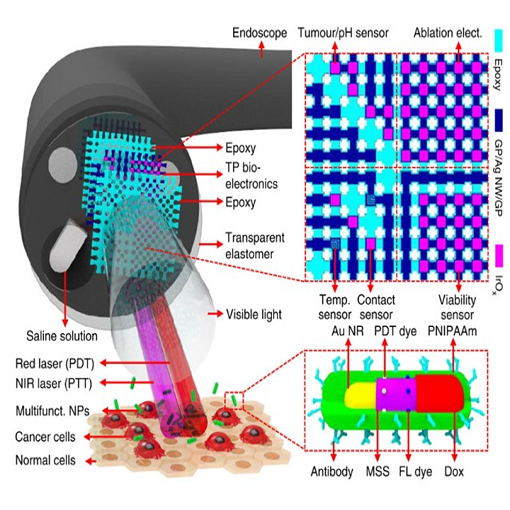
An Endoscope with Integrated Transparent Bioelectronics and Theranostic Nanoparticles for Colon Cancer Treatment
The gastrointestinal tract is a challenging anatomical target for diagnostic and therapeutic procedures for bleeding, polyps and cancerous growths. Advanced endoscopes that combine imaging and therapies within the gastrointestinal tract provide an advantage over stand-alone diagnostic or therapeutic devices. However, current multimodal endoscopes lack the spatial resolution necessary to detect and treat small cancers and other abnormalities. Here we present a multifunctional endoscope-based interventional system that integrates transparent bioelectronics with theranostic nanoparticles, which are photoactivated within highly localized space near tumours or benign growths. These advanced electronics and nanoparticles collectively enable optical fluorescence-based mapping, electrical impedance and pH sensing, contact/temperature monitoring, radio frequency ablation and localized photo/chemotherapy, as the basis of a closed-loop solution for colon cancer treatment. In vitro, ex vivo and in vivo experiments highlight the utility of this technology for accurate detection, delineation and rapid targeted therapy of colon cancer or precancerous lesions.
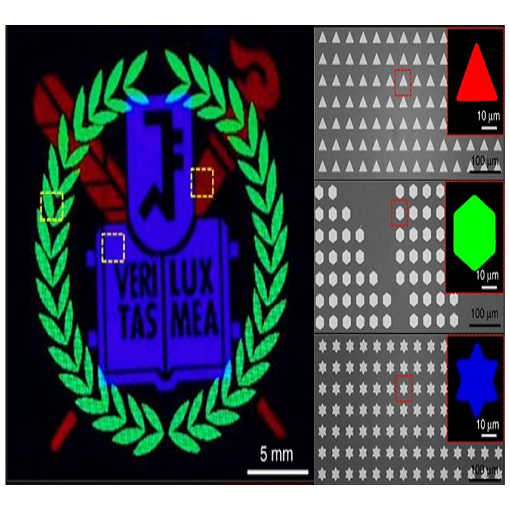
Wearable red–green–blue Quantum Dot Light-emitting Diode Array using High-resolution Intaglio Transfer Printing
Deformable full-colour light-emitting diodes with ultrafine pixels are essential for wearable electronics, which requires the conformal integration on curvilinear surface as well as retina-like high-definition displays. However, there are remaining challenges in terms of polychromatic configuration, electroluminescence efficiency and/or multidirectional deformability. Here we present ultra-thin, wearable colloidal quantum dot light-emitting diode arrays utilizing the intaglio transfer printing technique, which allows the alignment of red–green–blue pixels with high resolutions up to 2,460 pixels per inch. This technique is readily scalable and adaptable for low-voltage-driven pixelated white quantum dot light-emitting diodes and electronic tattoos, showing the best electroluminescence performance (14,000 cd m−2 at 7 V) among the wearable light-emitting diodes reported up to date. The device performance is stable on flat, curved and convoluted surfaces under mechanical deformations such as bending, crumpling and wrinkling. These deformable device arrays highlight new possibilities for integrating high-definition full-colour displays in wearable electronics.
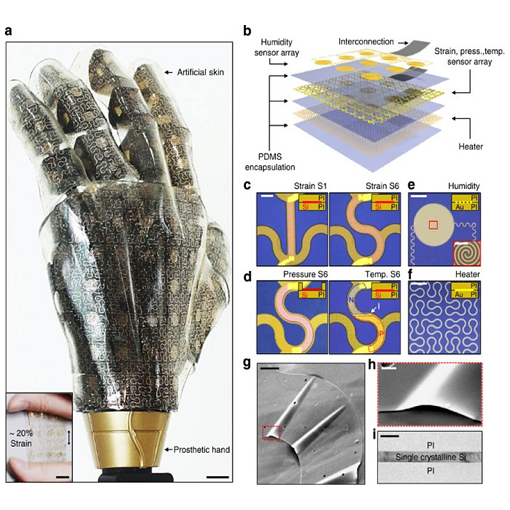
Stretchable Silicon Nanoribbon Electronics for Skin Prosthesis
Sensory receptors in human skin transmit a wealth of tactile and thermal signals from external environments to the brain. Despite advances in our understanding of mechano- and thermosensation, replication of these unique sensory characteristics in artificial skin and prosthetics remains challenging. Recent efforts to develop smart prosthetics, which exploit rigid and/or semi-flexible pressure, strain and temperature sensors, provide promising routes for sensor-laden bionic systems, but with limited stretchability, detection range and spatio-temporal resolution. Here we demonstrate smart prosthetic skin instrumented with ultrathin, single crystalline silicon nanoribbon strain, pressure and temperature sensor arrays as well as associated humidity sensors, electroresistive heaters and stretchable multi-electrode arrays for nerve stimulation. This collection of stretchable sensors and actuators facilitate highly localized mechanical and thermal skin-like perception in response to external stimuli, thus providing unique opportunities for emerging classes of prostheses and peripheral nervous system interface
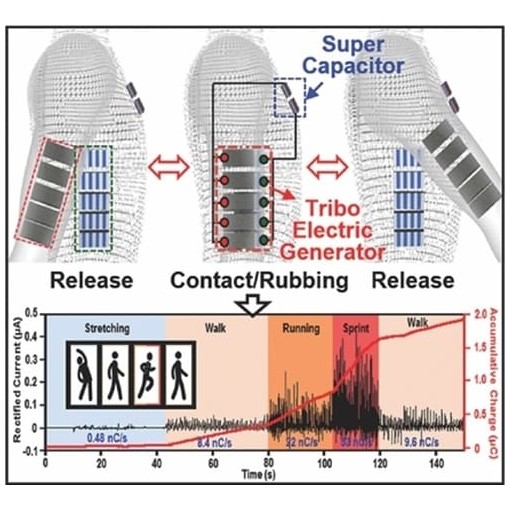
Fabric-Based Integrated Energy Devices for Wearable Activity Monitors
A wearable fabric-based integrated power-supply system that generates energy triboelectrically using human activity and stores the generated energy in an integrated supercapacitor is developed. This system can be utilized as either a self-powered activity monitor or as a power supply for external wearable sensors. These demonstrations give new insights for the research of wearable electronics.
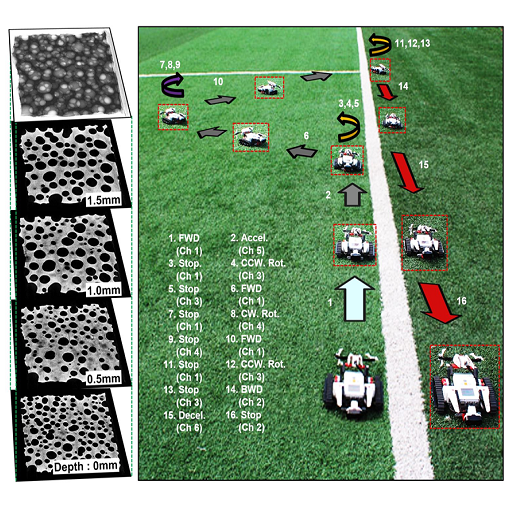
Reverse-Micelle-Induced Porous Pressure-Sensitive Rubber for Wearable Human–Machine Interfaces
A novel method to produce porous pressure-sensitive rubber is developed. For the controlled size distribution of embedded micropores, solution-based procedures using reverse micelles are adopted. The piezosensitivity of the pressure sensitive rubber is significantly increased by introducing micropores. Using this method, wearable human–machine interfaces are fabricated, which can be applied to the remote control of a robot.
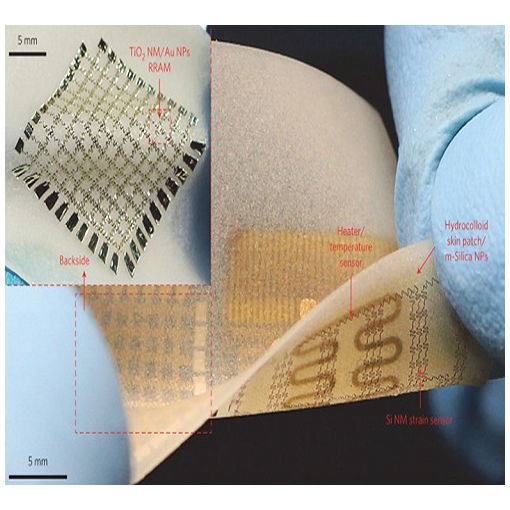
Multifunctional Wearable Devices for Diagnosis and Therapy of Movement Disorders
Wearable systems that monitor muscle activity, store data and deliver feedback therapy are the next frontier in personalized medicine and healthcare. However, technical challenges, such as the fabrication of high-performance, energy-efficient sensors and memory modules that are in intimate mechanical contact with soft tissues, in conjunction with controlled delivery of therapeutic agents, limit the wide-scale adoption of such systems. Here, we describe materials, mechanics and designs for multifunctional, wearable-on-the-skin systems that address these challenges via monolithic integration of nanomembranes fabricated with a top-down approach, nanoparticles assembled by bottom-up methods, and stretchable electronics on a tissue-like polymeric substrate. Representative examples of such systems include physiological sensors, non-volatile memory and drug-release actuators. Quantitative analyses of the electronics, mechanics, heat-transfer and drug-diffusion characteristics validate the operation of individual components, thereby enabling system-level multifunctionalities.
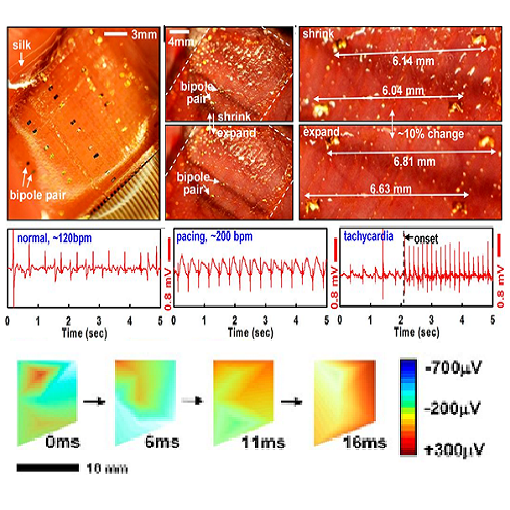
Electronic Sensor and Actuator Webs for Large-area Complex Geometry Cardiac Mapping and Therapy
Curved surfaces, complex geometries, and time-dynamic deformations of the heart create challenges in establishing intimate, nonconstraining interfaces between cardiac structures and medical devices or surgical tools, particularly over large areas. We constructed large area designs for diagnostic and therapeutic stretchable sensor and actuator webs that conformally wrap the epicardium, establishing robust contact without sutures, mechanical fixtures, tapes, or surgical adhesives. These multifunctional web devices exploit open, mesh layouts and mount on thin, bio-resorbable sheets of silk to facilitate handling in a way that yields, after dissolution, exceptionally low mechanical moduli and thicknesses. In vivo studies in rabbit and pig animal models demonstrate the effectiveness of these device webs for measuring and spatially mapping temperature, electrophysiological signals, strain, and physical contact in sheet and balloon-based systems that also have the potential to deliver energy to perform localized tissue ablation.
Proceedings of the National Academy of Sciences, 109: 19910, 2012
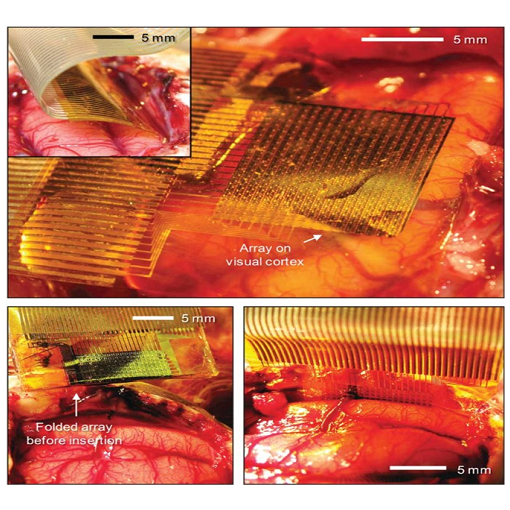
Flexible, Foldable, Actively Multiplexed, High-density Electrode Array for Mapping Brain Activity in Vivo
electrodes for recording and stimulating the brain are used throughout clinical medicine and basic neuroscience research, yet are unable to sample large areas of the brain while maintaining high spatial resolution because of the need to individually wire each passive sensor at the electrode-tissue interface. To overcome this constraint, we developed new devices that integrate ultrathin and flexible silicon nanomembrane transistors into the electrode array, enabling new dense arrays of thousands of amplified and multiplexed sensors that are connected using fewer wires. We used this system to record spatial properties of cat brain activity in vivo, including sleep spindles, single-trial visual evoked responses and electrographic seizures. We found that seizures may manifest as recurrent spiral waves that propagate in the neocortex. The developments reported here herald a new generation of diagnostic and therapeutic brain-machine interface devices.
Nature Neuroscience, 14: 1599, 2011

Epidermal Electronics
We report classes of electronic systems that achieve thicknesses, effective elastic moduli, bending stiffnesses, and areal mass densities matched to the epidermis. Unlike traditional wafer-based technologies, laminating such devices onto the skin leads to conformal contact and adequate adhesion based on van der Waals interactions alone, in a manner that is mechanically invisible to the user. We describe systems incorporating electrophysiological, temperature, and strain sensors, as well as transistors, light-emitting diodes, photodetectors, radio frequency inductors, capacitors, oscillators, and rectifying diodes. Solar cells and wireless coils provide options for power supply. We used this type of technology to measure electrical activity produced by the heart, brain, and skeletal muscles and show that the resulting data contain sufficient information for an unusual type of computer game controller.

